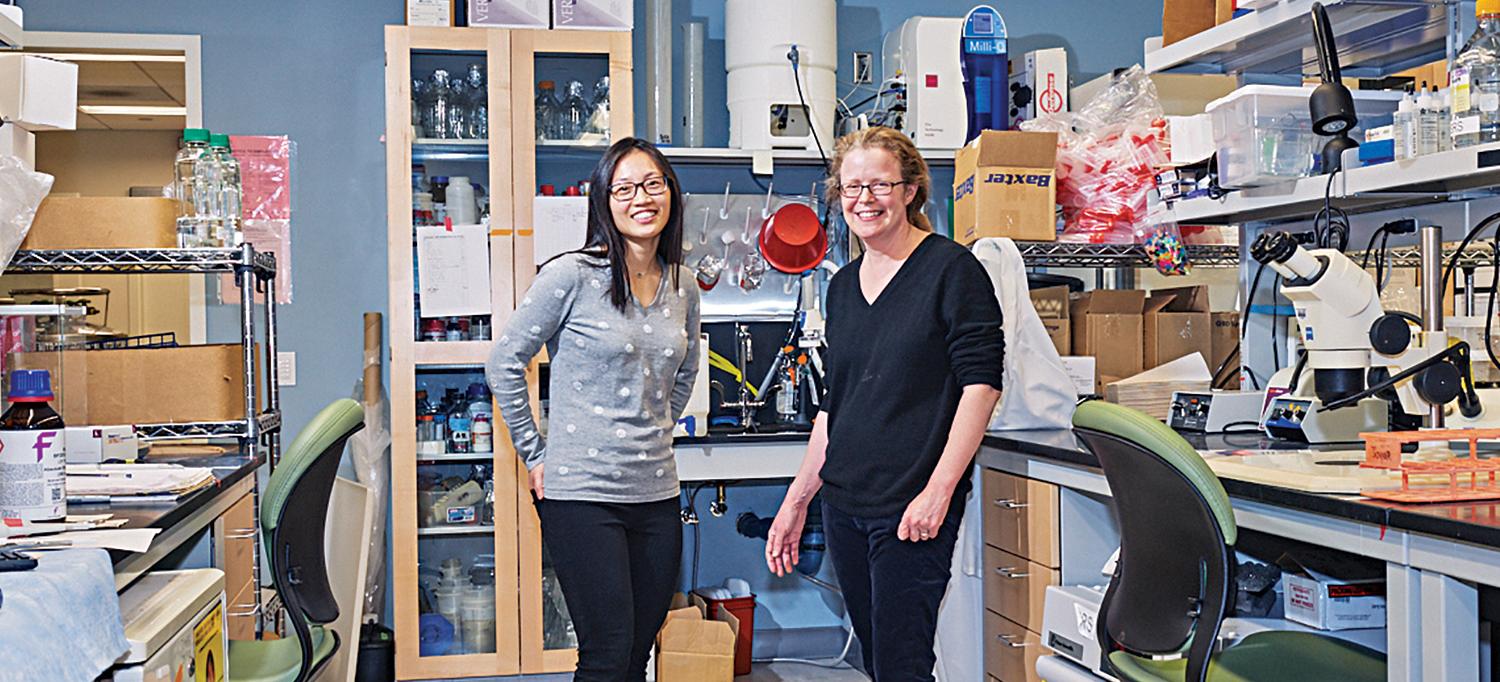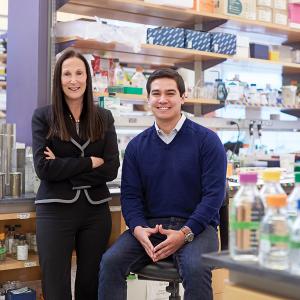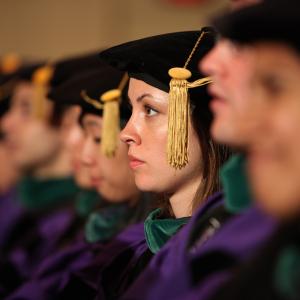An MD/PhD Student Helps an Esteemed Immunologist Map Signals That Dispatch Immune Cells to the Right Place at the Right Time

MD/PhD student Victoria Fang and Susan R. Schwab, PhD, associate professor in the Department of Pathology and member of the Skirball Institute of Biomolecular Medicine
Photo: Tony Luong
The human immune system must maintain a delicate balance as it summons the firepower to battle a wide range of infections, all while avoiding healthy tissue in the onslaught. The fine level of control depends in large part on the complex choreography of sending specific immune cells to the right place at the right time.
As an MD/PhD student at NYU School of Medicine’s Sackler Institute of Graduate Biomedical Sciences, Victoria Fang, 29, has patiently choreographed her own balancing act between clinical and research interests in immunology.
After enrolling in 2011, Fang coauthored multiple research publications, successfully defended her doctoral thesis in 2017, and recently began the clinical training portion of medical school. As an aspiring physician–scientist, she hopes to continue exploring the intricacies of the immune system and using that knowledge to help patients battle infections or avoid autoimmune diseases.
Susan R. Schwab, PhD, associate professor in the Department of Pathology and Fang’s thesis advisor, attributes her mentee’s success so far to her determination, insightfulness, smart critiques, and passion for research.
“I look for people who are really in it because they love science and who aren’t deterred when things don’t work the way they were hoping they would,” Dr. Schwab says. Setbacks are inevitable, but Fang says Dr. Schwab’s encouragement and “unquenchable curiosity” have motivated her to continue asking new research questions. “It’s a lot of hard work and a sprinkle of luck, but it’s one of the most interesting things I can imagine doing,” Fang says.
In the Schwab lab, she studied the signals that help determine when and where our immune cells move in response to perceived threats. Much of that action occurs within hundreds of lymph nodes, bean-shaped structures that store infection-fighting white blood cells. “A lot of cell types need to be in really precise spots of your lymph nodes in order to be effective and efficient in fighting the infections,” Fang says. “Localization is also really important so that immune cells don’t go to inappropriate places and cause inflammation and damage to your body. So it’s looking at two sides of the same coin.”
Within the lymph nodes, the lab found that signals based on varying concentrations of a small lipid molecule called sphingosine-1-phosphate (S1P) help immune cells find their assigned locations.
“But it’s very difficult to understand how the lipids work in the complexity of a whole animal because we don’t know where they are,” Dr. Schwab says. To help find them, the lab developed a genetically altered mouse that produces glowing proteins.
These fluorescent labels can map out varying concentrations of the S1P lipid, which act like illuminated pathways that direct immune cells to specific spots.
Fang learned computer coding and wrote a program to measure the lipid gradients in images of the mouse organs to better discern how they were directing the movement of immune cells. “She basically turned pretty pictures into quantifiable data,” Dr. Schwab says. “She was willing to master whatever was needed to find the answers.”
In her principal research, Fang found that a protein called SPNS2 produces S1P molecules in higher concentrations at the periphery of lymph nodes, where they act as beacons for immune specialists known as natural killer cells. With the chemical trail guiding them into place, natural killer cells can block the exits of lymph nodes and prevent disease-causing microbes from escaping and spreading throughout the body.
Beyond her main project, Fang was intrigued by the idea of treating autoimmune diseases such as multiple sclerosis by inhibiting the SPNS2 protein’s ability to create a separate trail of S1P molecules. This specific cue guides infection-fighting and inflammation-causing T cells out of lymph nodes and into battle. “The idea is if you could block this exit step and trap T cells in the lymph nodes, you might ameliorate a lot of autoimmune diseases that involve tissue destruction,” Dr. Schwab says. Based on what Dr. Schwab describes as a “very beautiful and convincing body of work,” Fang recently orchestrated a collaboration within NYU Langone Health’s Technology Ventures and Partnerships to initiate a screen for potential autoimmune drugs that target SPNS2.
NYU School of Medicine’s open and dynamic immunology research community, Fang says, was a big draw when she was considering graduate programs while an undergraduate at Amherst College in Massachusetts.
Dr. Schwab agrees that the uniquely collaborative atmosphere nurtures productive relationships that can empower young researchers like Fang. “When people are rooting for other people’s science, and offering genuine support, that tone permeates everything,” Dr. Schwab says.
After medical school, Fang hopes to pursue a residency in an immunology-related field like dermatology or hematology–medical oncology that will give her protected time for her research interests. Eventually, she’d like to balance her time between seeing patients and conducting more immunology research in her own lab.
Dr. Schwab has looked on with pride as Fang and other mentees have gained confidence and launched their careers.
Being a mentor for promising researchers like Fang, she says, has been one of her biggest joys. “I can’t wait to see what she does next.”
The Meaning of Mentorship
Dr. Susan Schwab describes her mentoring style as accessible; she encourages mentees to ask her anything. “A good mentor–mentee relationship is one where we like to talk to each other and get something out of every discussion,” she says. Even relatively small details can be enormously consequential, and she maintains an open-door policy to encourage her mentees to ask questions and brainstorm big-picture ideas with her.
MD/PhD student Victoria Fang says Dr. Schwab is incredibly generous with her time, creative with her teaching methods, and consistently makes mentoring a high priority. “That includes scientific and experimental design, helping me write, and giving me the opportunity to review papers and present at meetings,” Fang says. “There are so many facets of being a scientist, and sometimes it’s hard to get experience in all of those areas. Susan really encourages and tries to facilitate training and mentorship in all of them.”

